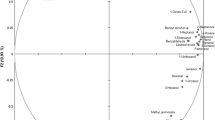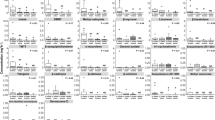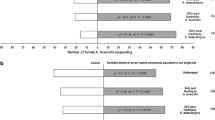Abstract
Liriomyza sativae Blanchard and Liriomyza huidobrensis (Blanchard) (Diptera: Agromyzidae) are two invasive flies in China that have caused economical damage on vegetables and ornamental plants. In this article, we report the profiles of emitted volatiles from healthy, mechanically damaged, and leafminer-damaged bean, Phaseolus vulgaris L., plants. Among 25 emitted volatiles identified, (E)-2-hexen-1-al, (3E)-4,8-dimethyl-1,3,7-nonatriene (DMNT), (Z)-3-hexenyl acetate, (Z)-3-hexen-1-ol, (syn)- and (anti)-2-methylpropanal oxime, (syn)-2-methylbutanal oxime, linalool, and (E,E)-α-farnesene were consistently released from damaged bean plants. Combined amounts of these nine compounds made up more than 70% of the total volatiles emitted from each treatment. No qualitative differences in volatile emission were found between bean plants damaged by the two fly species; however, amounts of several major compounds induced by L. huidobrensis damage were significantly higher than those from plants damaged by L. sativae. The mechanically damaged plants released a higher proportion of green leaf volatiles than plants in the other treatments, whereas leafminer-damaged plants produced more terpenoids and oximes. Furthermore, the volatile profiles emitted from plants, damaged by adult leafminers, by second instar larvae, and even the plants with empty mines left by leafminer larvae (the pupal stage) were significantly different. The identification of volatile oximes released from damaged plants was confirmed and is discussed in a behavioral and biological control context.





Similar content being viewed by others
Abbreviations
- CLP:
-
Bean plants with cut leaves
- CTRL:
-
Clean bags
- DMNT:
-
(3E)-4,8-Dimethyl-1,3,7-nonatriene
- GC–MS:
-
Gas chromatography–mass spectrometry
- Lh-EMP:
-
Bean plants with empty mines left by L. huidobrensis larvae
- Lh-FOP:
-
Bean plants on which Liriomyza huidobrensis had fed and oviposited
- Lh-LP:
-
Bean plants infested with L. huidobrensis 2nd-instar larvae
- Ls-EMP:
-
Bean plants with empty mines left by L. sativae larvae
- Ls-FOP:
-
Bean plants on which L. sativae had fed and oviposited
- Ls-LP:
-
Bean plants infested with L. sativae 2nd-instar larvae
- NPP:
-
Bean plants with needle-punctured leaves
- TMTT:
-
(3E,7E)-4,8,12-Trimethyl-1,3,7,11-tridecatetraene
- UP:
-
Undamaged bean plants
References
Andersson S (2003) Antennal responses to floral scents in the butterflies Inachis io, Aglais urticae (Nymphalidae), and Gonepteryx rhamni (Pieridae). Chemoecology 13:13–20
Chen B, Kang L (2004) Variation in cold hardiness of Liriomyza huidobrensis (Diptera: Agromyzidae) along latitudinal gradients. Environ Entomol 33:155–164
Chen B, Kang L (2005) Can the greenhouse eliminate the development of leafminer cold tolerance? Oecologia 144:187–195
Connor EF, Taverner MP (1997) The evolution and adaptive significance of the leaf-mining habit. Oikos 79:6–25
De Boer JG, Posthumus MA, Dicke M (2004) Identification of volatiles that are used in discrimination between plants infested with prey or nonprey herbivores by a predatory mite. J Chem Ecol 30:2215–2230
De Moraes CM, Lewis WJ, Paré PW, Alborn HT, Tumlinson JH (1998) Herbivore-infested plants selectively attract parasitoids. Nature 393:570–573
Dicke M, Hilker M (2003) Induced plant defences: from molecular biology to evolutionary ecology. Basic Appl Ecol 4:3–14
Dicke M, Minkenberg OPJM (1991) Role of volatile infochemicals in foraging behavior of the leafminer parasitoid Dacnusa sibirica Telenga. J Insect Behav 4:489–500
Dicke M, Sabelis MW, Takabayashi J, Bruin J, Posthumus MA (1990) Plant strategies of manipulating predator–prey interactions through allelochemicals: prospects for application in pest control. J Chem Ecol 16:3091–3118
Du Y, Poppy GM, Powell W, Pickett JA, Wadhams LJ, Woodcock CM (1998) Identification of semiochemicals released during aphid feeding that attract parasitoid Aphidius ervi. J Chem Ecol 24:1355–1368
Finidori-logli V, Bagnéres A, Clément J (1996) Role of plant volatiles in the search for a host by parasitoid Diglyphus isaea (Hymentoptera: Eulophidae). J Chem Ecol 22:541–558
Fritzsche Hoballah ME, Tamo C, Turlings TCJ (2002) Differential attractiveness of induced odors emitted by eight maize varieties for the parasitoid Cotesia marginiventris: is quality or quantity important? J Chem Ecol 28:951–968
Gouinguené SP, Turlings TCJ (2002) The effects of abiotic factors on induced emissions in corn plant. Plant Physiol 129:1296–1307
Gouinguené S, Alborn H, Turlings TCJ (2003) Induction of volatile emissions in maize by different larval instars of Spodoptera littoralis. J Chem Ecol 29:145–162
Guerrieri E, Poppy GM, Powell W, Tremblay E, Pennachio F (1999) Induction and systemic release of herbivore-induced plant volatiles mediating in-flight orientation of Aphidius ervi. J Chem Ecol 25:1247–1261
Hartmann T (2004) Plant-derived secondary metabolites as defensive chemicals in herbivorous insects: a case study in chemical ecology. Planta 219:1–4
Kang L (1996) Ecology and sustainable control of serpentine leafminers. Science Press, Beijing
Kessler A, Baldwin IT (2001) Defensive function of herbivore-induced plant volatile emissions in nature. Science 291:2141–2144
Loughrin JH, Manukian A, Heath RR, Turlings TCJ, Tumlinson JH (1994) Diurnal cycle of emission of induced volatile terpenoids by herbivore-injured cotton plants. Proc Natl Acad Sci USA 91:11836–11840
Mattiacci L, Rocca BA, Scascighini N, D’Alessandro M, Hern A, Dorn S (2001) Systemically-induced plant volatiles emitted at the time of danger. J Chem Ecol 27:2233–2252
Paré PW, Tumlinson JH (1997a) Induced synthesis of plant volatiles. Nature 385:30–31
Paré PW, Tumlinson JH (1997b) De novo biosynthesis of volatiles induced by insect herbivory in cotton plants. Plant Physiol 114:1161–1167
Paré PW, Tumlinson JH (1999) Plant volatiles as defense against insect herbivores. Plant Physiol 121:325–331
Parrella MP (1987) Biology of Liriomyza. Annu Rev Entomol 32:201–224
Parrella MP, Bethke JA (1984) Biological studies of Liriomyza huidobrensis (Diptera: Agromyzidae) on chrysanthemum, aster, and pea. J Econ Entomol 77:342–345
Petitt FL, Turlings TCJ, Wolf SP (1992) Adult experience modifies attraction of the leafminer parasitoid Opius dissitus (Hymenoptera: Braconidae) to volatile semiochemicals. J Insect Behav 5:623–634
Piechulla B, Pott MB (2003) Plant scents—mediators of inter- and intraorganismic communication. Planta 217:687–689
Rasmann S, Kollner TG, Degenhardt J, Hiltpold I, Toepfer S, Kuhlmann U, Gershenzon J, Turlings TCJ (2005) Recruitment of entomopathogenic nematodes by insect-damaged maize roots. Nature 434:732–737
Röse USR, Tumlinson JH (2004) Volatiles released from cotton plants in response to Helicoverpa zea feeding damage on cotton flower buds. Planta 218:824–832
Röse USR, Tumlinson JH (2005) Systemic induction of volatile release in cotton: how specific is the signal to herbivory? Planta 222:327–335
Salvo A, Valladares GR (2004) Looks are important: parasitic assemblages of agromyzid leafminers (Diptera) in relation to mine shape and contrast. J Anim Ecol 73:494–505
Spencer KA (1973) Agromyzidae (Diptera) of economic importance. Series Entomologica 9. Dr. W. Junk, The Hague
Spencer KA (1990) Host specialization in the world Agromyzidae (Diptera). Series Entomologica 45. Kluwer, Dordrecht
Takabayashi J, Takahashi S, Dicke M, Posthumus MA (1995) Developmental stage of herbivore Pseudaletia separata affects production of herbivore-induced synomone by corn plants. J Chem Ecol 21:273–287
Turlings TCJ, Wäckers F (2004) Recruitment of predators and parasitoids by herbivore-injured plants. In: Cardé RT, Millar JG (eds) Advances in insect chemical ecology. Cambridge University Press, Cambridge, pp 21–75
Turlings TCJ, Tumlinson JH, Lewis WJ (1990) Exploitation of herbivore-induced plant odors by host-seeking parasitic wasps. Science 250:1251–1253
Turlings TCJ, Loughrin JH, Mccall PJ, Röse US, Lewis WJ, Tumlinson JH (1995) How caterpillar-damaged plants protect themselves by attracting parasitic wasps. Proc Natl Acad Sci USA 92:4169–4174
Turlings TCJ, Bernasconi M, Bertossa R, Bigler F, Caloz G, Dorn S (1998a) The induction of volatile emissions in maize by three herbivore species with different feeding habits: possible consequences for their natural enemies. Biol Control 11:122–129
Turlings TCJ, Lengwiler UB, Bernasconi ML, Wechsler D (1998b) Timing of induced volatile emissions in maize seedlings. Planta 207:146–152
Van Den Boom CEM, Van Beek TA, Posthumus MA, Groot A, Dicke M (2004) Qualitative and quantitative variation among volatile profiles induced by Tetranychus urticae feeding on plants from various families. J Chem Ecol 30:69–89
Vet LEM, Dicke M (1992) Ecology of infochemical use by natural enemies in a tritrophic context. Annu Rev Entomol 37:141–172
Wei JN, Zou L, Kuang RP, He LP (2000) Influence of leaf tissue structure on host feeding selection by pea leafminer Liriomyza huidobrensis (Diptera: Agromyzidae). Zool Stud 39:295–300
Zhao YX, Kang L (2000) Cold tolerance of the leafminer Liriomyza sativae (Diptera: Agromyzidae). J Appl Entomol 124:185–189
Zhao YX, Kang L (2002a) The role of plant odours in the leafminer Liriomyza sativae (Diptera: Agromyzidae) and its parasitoid Diglyphus isaea (Hymenoptera: Eulophidae): orientation towards the host habitat. Eur J Entomol 99:445–450
Zhao YX, Kang L (2002b) Role of plant volatiles in host plant location of the leafminer, Liriomyza sativae (Diptera: Agromyzidae). Physiol Entomol 27:103–111
Zhao YX, Kang L (2003) Olfactory responses of the leafminer Liriomyza sativae (Dipt., Agromyzidae) to the odours of host and non-host plants. J Appl Entomol 127:80–84
Acknowledgements
We express our sincere thanks to Prof. W. Boland, Dr. S. Bartram (Max Planck Institute for Chemical Ecology, Jena, Germany), and Dr. R. Kaiser (Givaudan Schweiz AG) for providing important reference compounds; to Prof. C. H. Zhao (Institute of Zoology, Chinese Academy of Sciences, Beijing, China) for donating some authentic volatile compounds and GC assistance; to Dr. T.C.J. Turlings (Institute of Zoology, University of Neuchatel, Neuchatel, Switzerland) for literature donations and homoterpene confirmation; and to Dr. Y. X. Zhao (the managing editor of Insect Science, Institute of Zoology, Chinese Academy of Sciences) for advice and technical assistance. This study was supported by Chinese Academy of Science (Grant No. KSCX2-SW-105) and a special grant from China Ministry of Science and Technology (State Key Basic Research and Development Grant No. G2000046803). J.N.W. gratefully acknowledges the support of K. C. Wong Education Foundation, Hong Kong.
Author information
Authors and Affiliations
Corresponding author
Electronic supplementary material
Rights and permissions
About this article
Cite this article
Wei, JN., Zhu, J. & Kang, L. Volatiles released from bean plants in response to agromyzid flies. Planta 224, 279–287 (2006). https://doi.org/10.1007/s00425-005-0212-x
Received:
Accepted:
Published:
Issue Date:
DOI: https://doi.org/10.1007/s00425-005-0212-x




